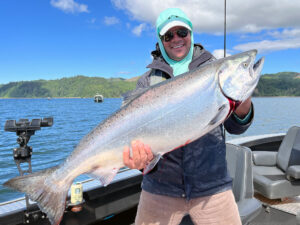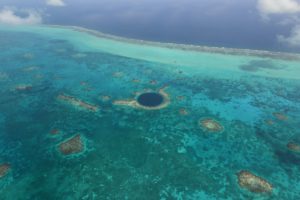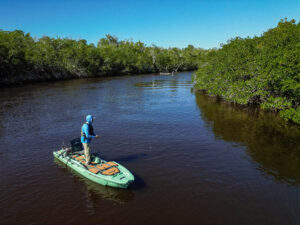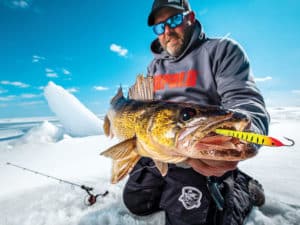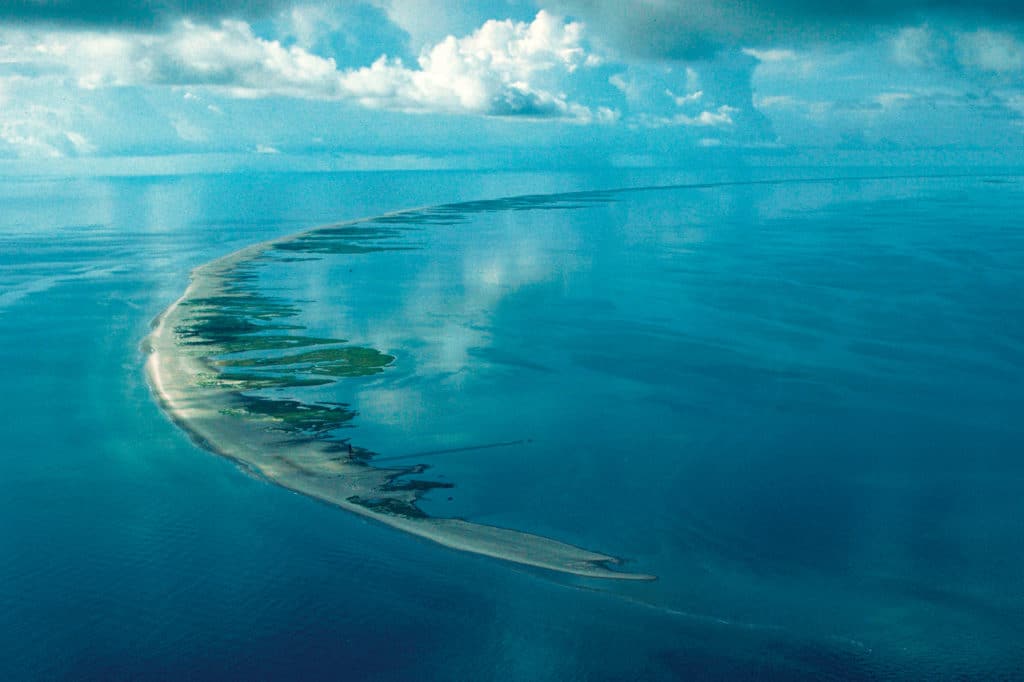
40 Miles Out and Nothing but Shallows
Jim Hendricks throttled off from Southern Way as I called out directions from the front of our 14-foot V-bottom skiff. SF‘s editor, Chris Woodward, and senior managing editor, Stephanie Pancratz, trailed behind us in an identical fiberglass boat, their heads looking east toward the picturesque Chandeleur Islands.
With a night of storms safely in our rear view, the entire editorial staff of Sport Fishing was ecstatic to explore the pristine waters 40 miles south of the Mississippi coast, notorious for 100-fish days. Capt. Brian Gagnon had safely moored the mothership the night prior in a protected tongue of deep water west of the crescent-shaped islands, less than a half-mile from productive sandbars, mangroves, mud flats, creeks and grass flats.
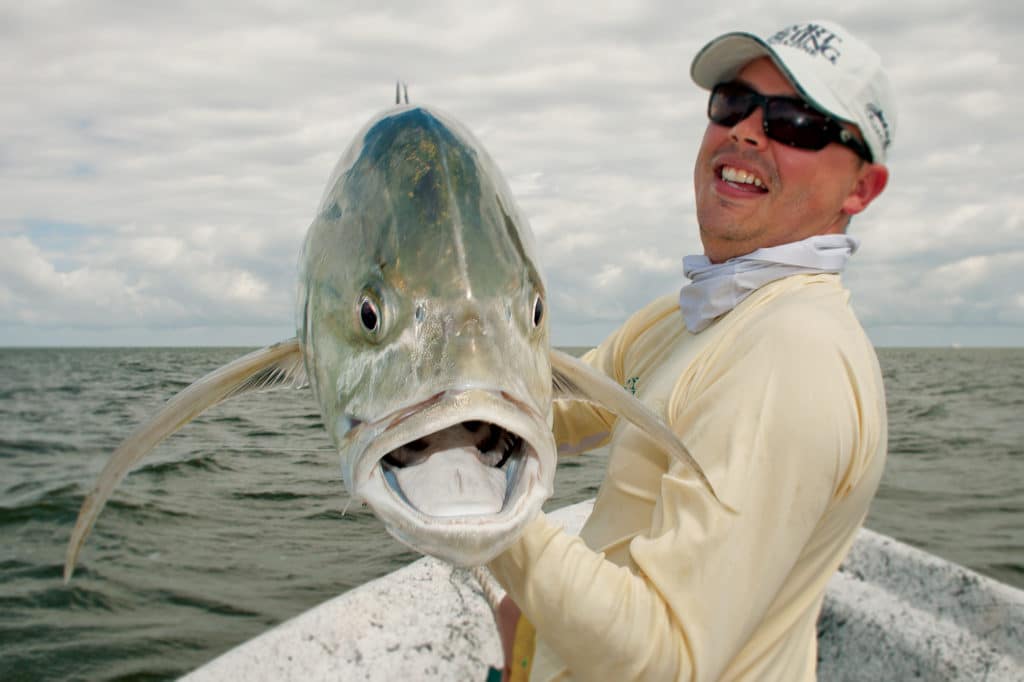
Jack Attack
Our first stop that June morning was a tidal flat to the south, near Redfish Point, situated about halfway down the main chain of islands. Mullet, including some massive individuals, loitered over the 3-foot flats in complete disregard of predators. Since the bait was on top, I cast a topwater lure with 20-pound spinning gear; Southern Way mates Shane Hicks and Jeremy McHugh had recommended walk-the-dog baits such as Rapala Skitter Walks and MirrOlure Top Dogs.
A massive fish boiled on my lure twice, finally coming tight to the reel. I confided in Hendricks, Sport Fishing‘s Pacific Coast editor, how glad I was to have packed a heavier rod — this fish dumped line, didn’t jump and definitely wanted nowhere near the boat. Eventually I recognized the distinct pattern of tail pumps, culminating in a hefty 25-pound jack crevalle tiring beside the boat. After a quick dehook and photo, the oversize jack went back into the water.
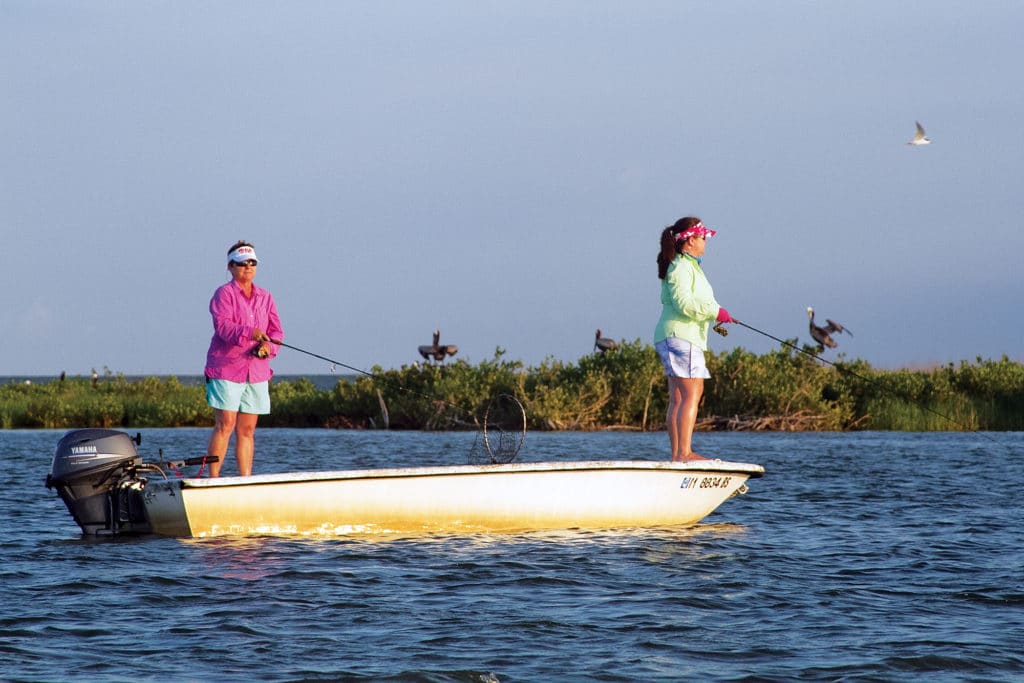
Drift and Cast
Nearby, Pancratz and Woodward drifted across their own flat, plugging away at whatever hid in the green water. Within earshot, Doug Olander, editor-in-chief of Sport Fishing, pedaled a Hobie Pro Angler in our direction, opting to fish with foot power instead of horsepower.
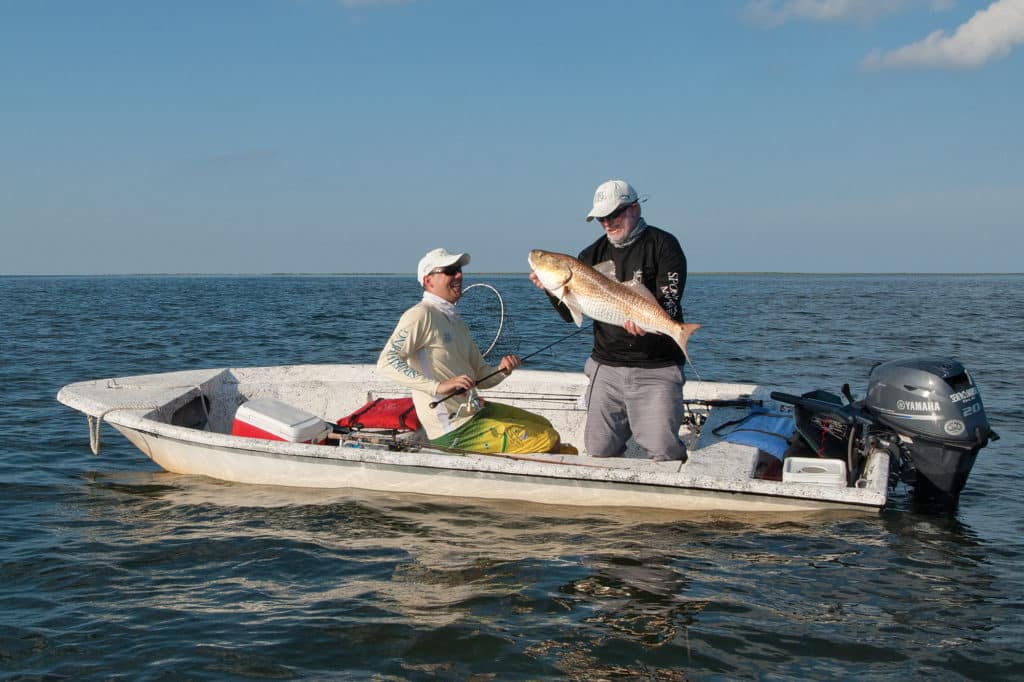
Bulls on Top
Not to be outdone, Hendricks later hooked his own giant on the same flat. Instead of yellow fins, his fish was emblazoned in red with a black-spot accent at the tail. I cranked the tiller engine and followed a trail of braided line and sea grass as Hendricks gained line back on his spool. By the time he got his bull in the boat, the entire Sport Fishing crew had arrived to watch the performance. Hendricks’ red drum catch highlighted the attraction of the Chandeleurs; not only can the islands offer prolific numbers of game fish, but often those fish are showstoppers.
How to Get to the Chandeleur Islands
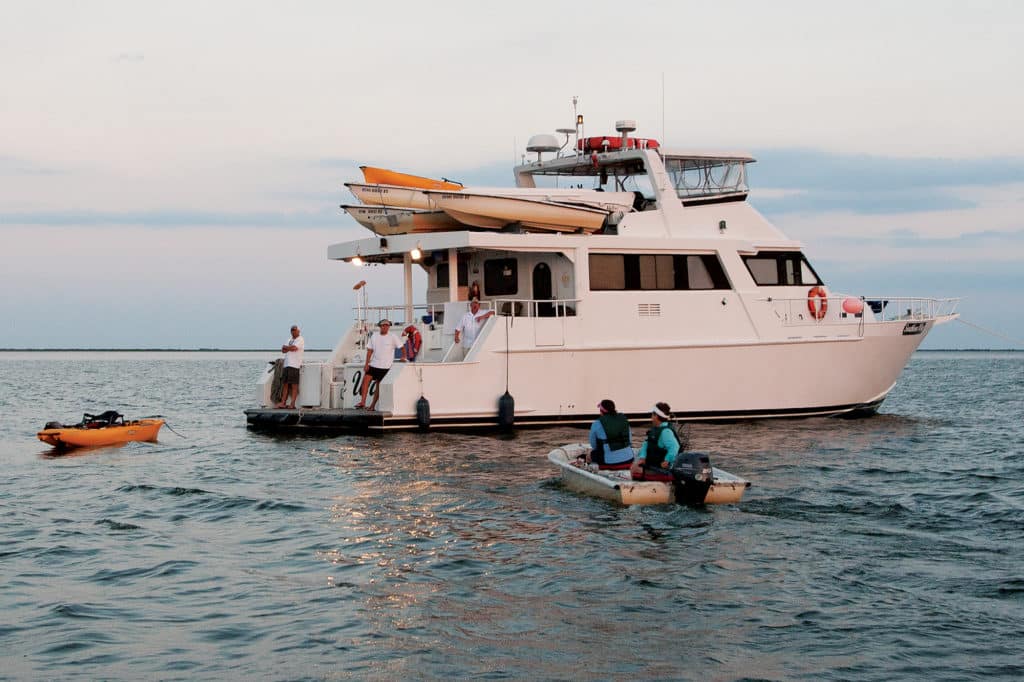
The Chandeleur Islands sit about 40 miles south of Gulfport, Mississippi, and 60 miles east of New Orleans, making the islands readily accessible to anglers in both states. As part of the Breton National Wildlife Refuge, the islands officially reside in Louisiana waters. Shallow Gulf waters — averaging no more than 15 feet in most places, and generally much less — allow shallow-draft mothership boats like Southern Way to ride anglers out to the grounds.
“We offer three- to seven-day trips to the islands,” says Gagnon. “Typically, trips begin on Thursday or Sunday. We leave the docks around midnight, and have room for up to 12 anglers to sleep and fish.”
The first morning, a full breakfast waited for us, and all the skiffs were prepped to fish the islands. Each skiff was plucked off the top deck with help from a crane, and launched before we even left the galley. Mates packed our skiffs with tackle and gear, a cooler full of drinks, a VHF radio, life jackets, and a topped-out gas tank. Then we were on our own to explore, just two to a boat (and one in a kayak).
McHugh explained that March through July are the top months for seatrout, and that smaller redfish are available year-round on the grass flats. “The east and southeast winds are perfect for fishing these islands,” says Gagnon, “though the end of July can become too hot for consistent bites.”
Shoalwater Bay, consisting of the North and New Harbor islands, is one seatrout hot spot, though any shallow-water flat to 3 to 4 feet has fish-holding potential. Inside the bay, a massive school of cownose rays fooled us one evening, with the tips of their “wings” out of the water, until we were able to identify them.
“Cobia and tarpon even show from May to July, mostly as migratory strays along the east coast of the islands and along the northern tip,” says Gagnon. “The cobia hang along sandbars at the North Tip consistently; tournament anglers from Biloxi fish the area.”
Chandeleur Islands Species Availability
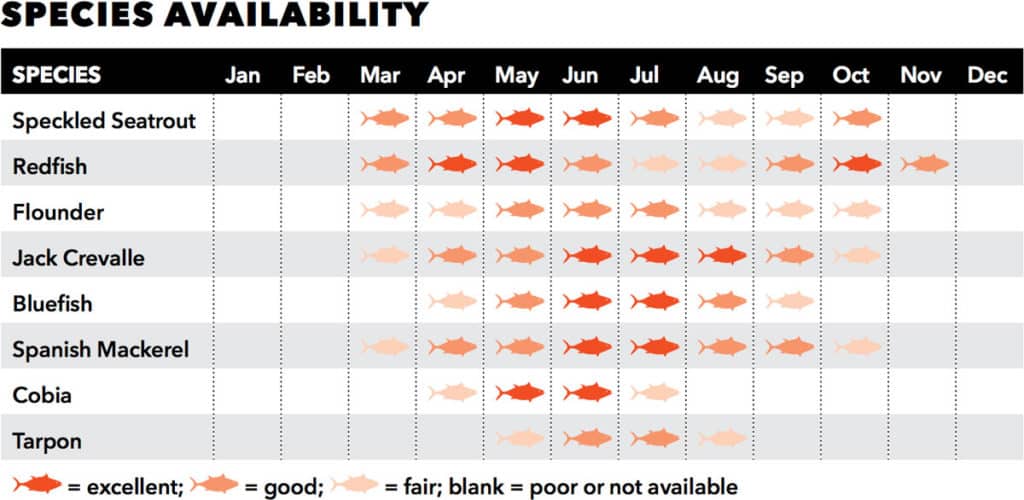
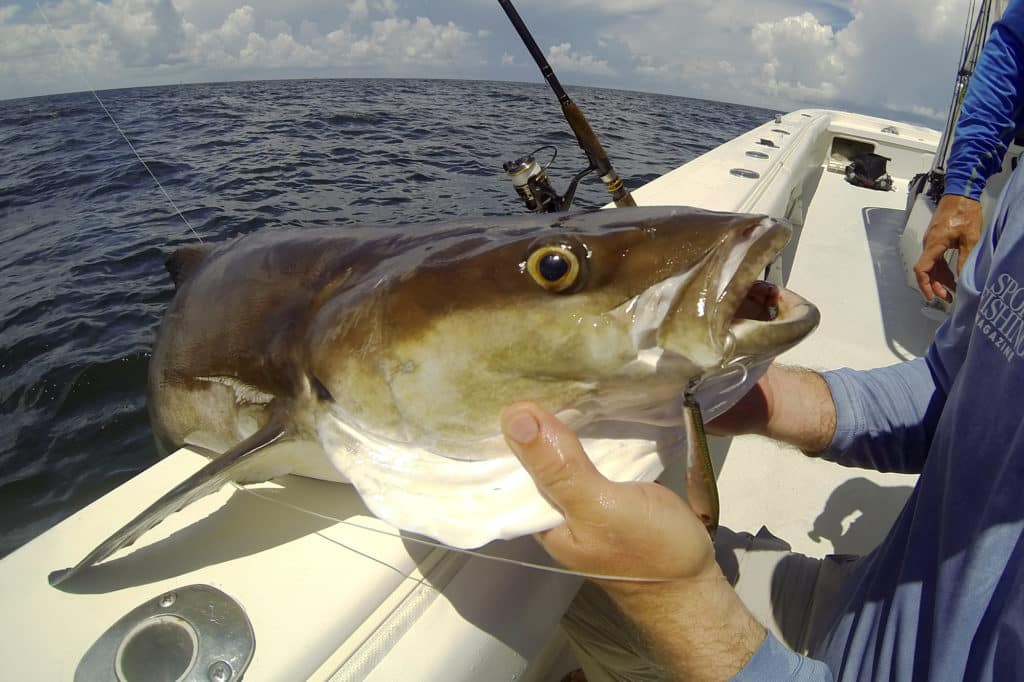
The Houseboat Flats
North along the Chandeleurs is an expansive flat demarcated by a weathered houseboat at the mouth of a series of creeks. The grass flat out front of the creeks produced a number of species for us, especially when incoming tides allowed us to drift higher onto the flat. Olander made it all the way to the island in his ’yak, able to explore areas we couldn’t reach.
The farther east we drifted, the more pelican and frigate-bird guano we smelled wafting from the barrier islands — a small price to pay to experience such a lively rookery. In quick succession, Pancratz hooked seatrout, redfish and a small blacktip shark all on the same drift. The flats were alive, and we spooked sheepshead, redfish, sharks and catfish while prospecting. Hendricks and I cast soft baits on jig heads, and landed enough reds and seatrout for a fish dinner for everyone on the trip.
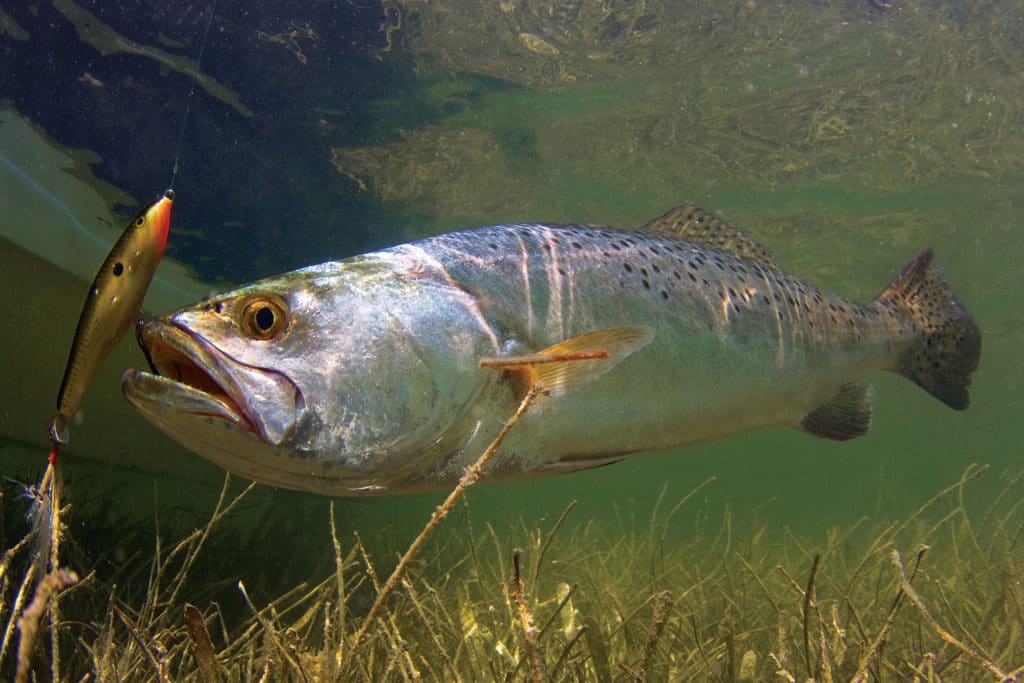
Slipping off the flat, Hendricks and I ventured up a nearby creek, casting along the edges and scouting for larger reds. The many creeks that cut through these islands are often very shallow, filled in with sand over the years — finding one that is lined with mangroves and deep enough to float a skiff is the ticket. Mud flats at the mouths of creeks are also seatrout aggregators, says Gagnon.
In the dead end of a creek, I plucked a flounder on a jig from a sandy flat to complete our boat slam. I remembered that Gagnon mentioned these creeks as exceptional at night for flounder-giggers who use bright lights to spot fish. Apparently, the flounder hang in the creeks during the day; the skiff spooked more than a couple while drifting.
We beached our skiff on an open bank and walked across a sandy berm that led us to the unprotected east side of the Chandeleurs. Our buddy boat, with Woodward and Pancratz, parked inside a different creek and met us along the shore break. The water that usually allows wade-fishing for specks was overcome with white water and roiled with sand. A 4-foot shark poked its fins above the waves, scouting the intertidal zone in waters that lapped our kneecaps. We had battled annoying weather all trip, and this day was no different, but we promised ourselves that we would explore these waters again the next day.
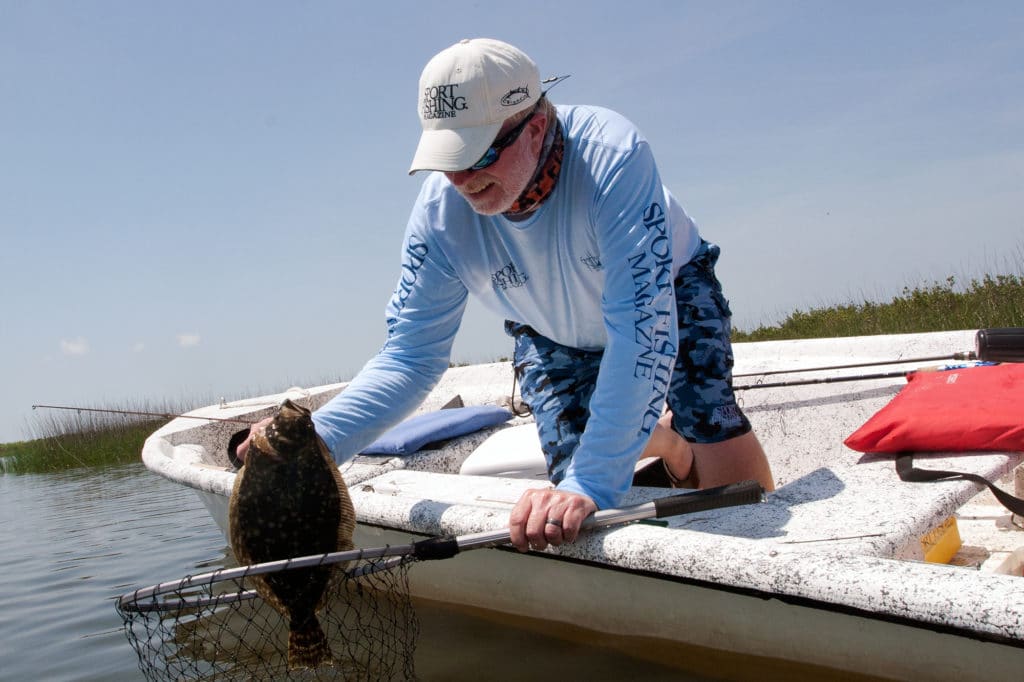
East Coast, Beast Coast
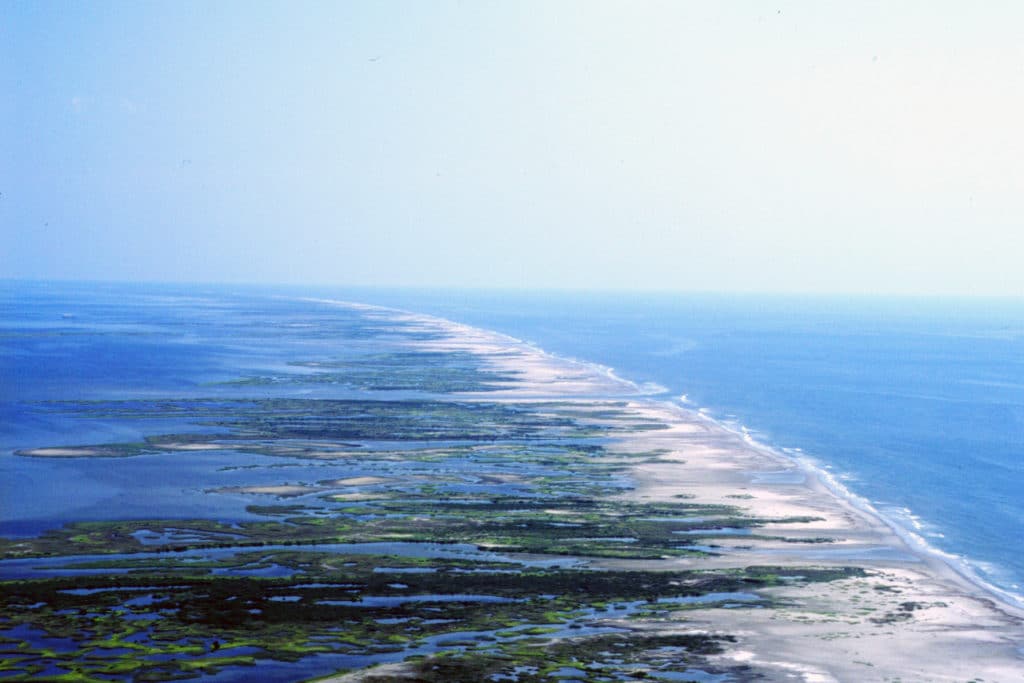
The last morning, both boats motored south down Big Smack Channel to a cut that runs north of Curlew Island. With no electronics on board our basic skiffs, we used GPS-compatible phone apps from Navionics to locate our map position. One of the few towers that remain on the island also helped with line-of-sight navigation.
Getting through the pass proved difficult, especially when judging and dodging breaking waves that signaled shallow water. Once in the clear, we stayed 30 to 40 yards offshore, mostly to combat the persistent swell. “Schools of big bull reds turn the water red here from March to May, but particularly around Easter,” says Gagnon. “You can throw a bare hook out and catch them.”
When the water’s calm, three troughs running parallel to the eastern side of the island provide redfish and speckled trout habitat. “If you’re wading, head out to the first bar and cast to the second bar,” he says, “or you can cruise down the shore in the boat, looking for ditches on the falling tide.”
Neither of those tactics was possible this day, but both boats trolled swimbaits and lipped plugs near immense schools of mullet to catch jacks, bluefish, sharks, ladyfish and sennet before heading back to the other side of the islands. (The sennet is a small member of the barracuda family, never measuring longer than 2 feet.)
I spotted Olander well off in the distance on the way in, far west of the islands, channel and even the ship. Catching up to him, we saw that he was hooked into a jack crevalle so massive, I wasn’t sure he’d get it into his kayak so we could take a photo. Plus, he was using light tackle. “First, I caught a nice red on a big Sebile Magic Swimmer Soft — to imitate the mullet — at the flat near Redfish Point,” he said, pointing in the direction of the islands. “Then I hooked into this; I’ve been dragged around for the past half-hour.”
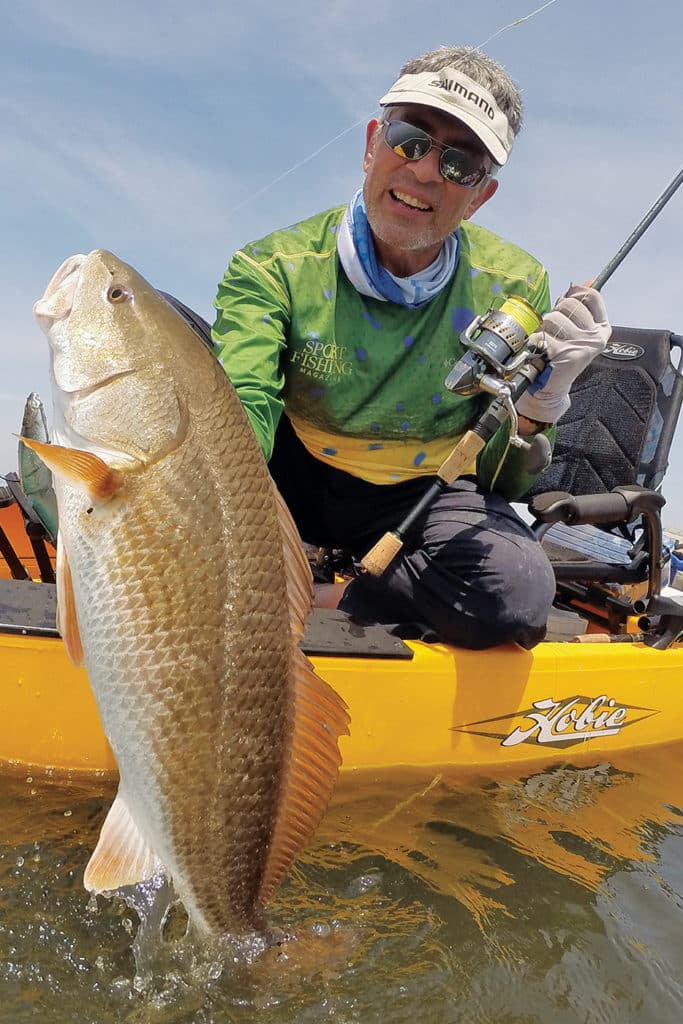
Change is Inevitable
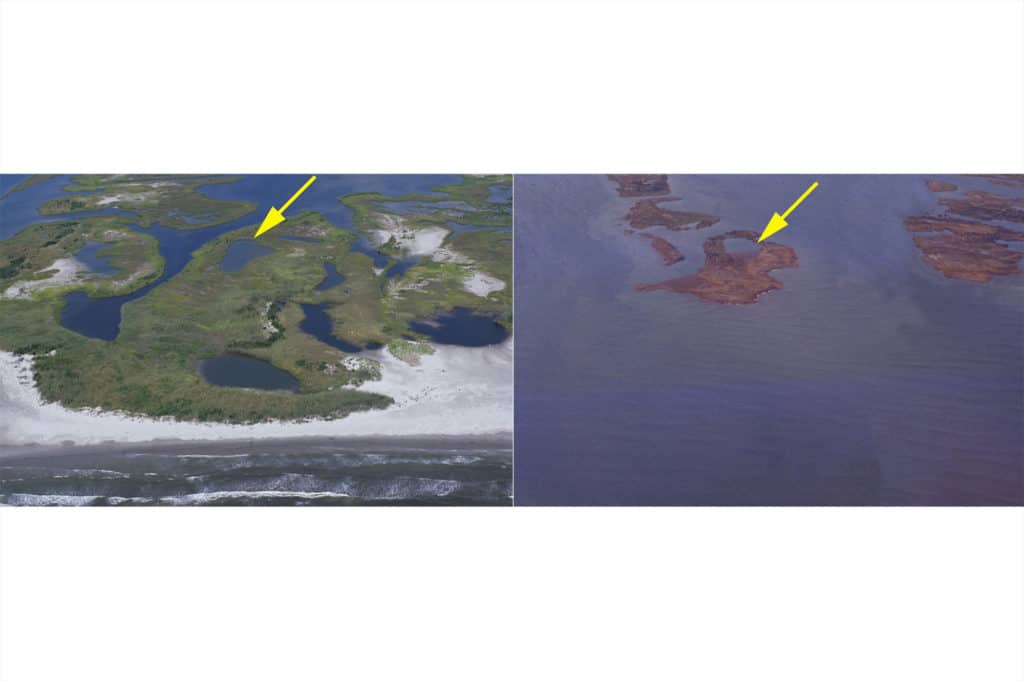
We were fortunate to explore these islands in June of last year. You can too, and probably your kids and grandkids. But it’s painfully clear that these islands are disappearing. After hurricanes Georges (1998), Lili (2002), Ivan (2004) and Isaac (2012), the landscape has dramatically changed due to wave-action erosion.
The Chandeleurs are a barrier chain including Breton Island, Grand Gosier Islands and Curlew Islands. They create a natural buffer zone between the Gulf and mainland, protecting cities like New Orleans from wind and storm surge. Hurricanes Dennis and Katrina’s (2005) impact was so severe that the historic Chandeleur Island Lighthouse perished. The United States Geological Survey keeps track of the Chandeleurs after major storms, documenting the islands’ continuing transformation with before-and-after aerial imagery.
“In an effort to stop oil from the 2010 spill getting to the island, huge sand berms were built,” says Gagnon. “But all that sand pushed into the bayous, filling many of them. Those bayous used to hold trout in the wintertime, but they don’t anymore. The sea grass regrows after winter dormancy, but not as much.”
Gagnon wouldn’t be surprised to see the rest of the 13 miles of fishable islands gone within his lifetime, he says. “In 1955, there were 77 miles of island.” For now, the Chandeleurs still offer an exceptional, remote, shallow-water fishery 40 miles into the Gulf, free of the urban effects of industry, pollution or overfishing. Who knows exactly what the future holds, but so far anglers have adapted well and continue to enjoy the action in multiday fishing adventures.
Chandeleur Islands Fishing Trip Checklist
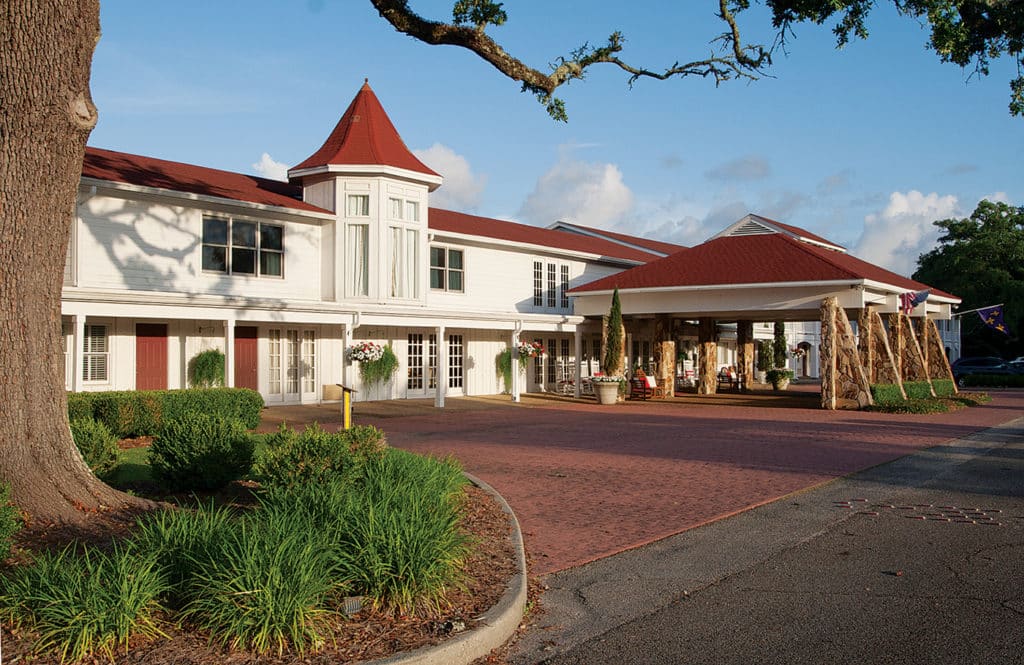
Before ever hopping on a Chandeleur mothership, you’ll want to stay at least one night on land. At the time of our trip, Southern Way left port out of the Gulfport Harbor, so we reached out to Mississippi Tourism’s Mike Jones for a lodge recommendation. He set us up for a couple of nights at the beautiful and historical Gulf Hills Hotel and Conference Center in nearby Ocean Springs. Gulf Hills has easy access to Biloxi Bay and is home to the second-oldest golf course on the Mississippi Gulf Coast.
“The hotel was built in 1937, and Al Capone and fellow mobsters used the hotel as a hangout,” says Donna Brown, general manager at the resort. “They used to ship bootleg alcohol from Canada to Chicago, then down the railroad to the Mississippi area. The rumrunners used Biloxi as a base, so plenty of entertainers at the time held shows at the hotel for the mobsters.”
While at the resort, each editor bought a three-day skiff license online from the Louisiana Department of Wildlife and Fisheries. It’s the only license necessary to fish the Chandeleur Islands.
For tackle, pack a mix of topwaters, ¼-ounce jig heads with various styles of soft baits, spinnerbaits, spoons and popping corks — your typical Gulf Coast arsenal. Bait-casting or spinning gear works best in the 10- to 20-pound class, but I always lean toward lighter lines for the best sport.
The Southern Way
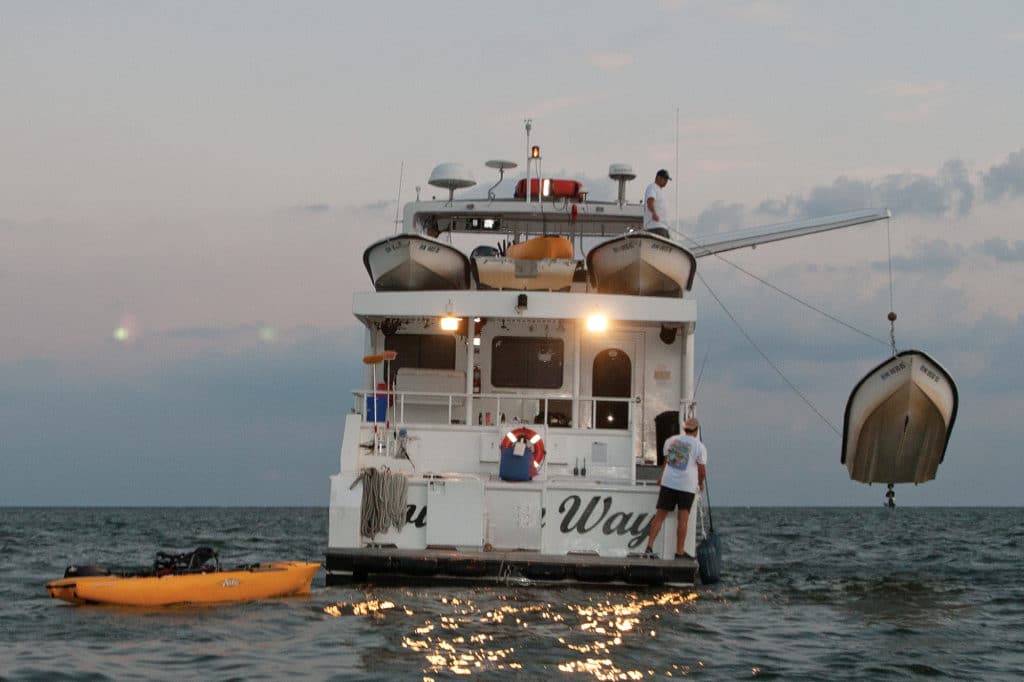
Southern Way Charters specializes in a host of fishing and duck-hunting excursions, with co-ownership and operations run by Capt. Bart Haddad. For our trip to the Chandeleur Islands, we slept, ate and showered on the comfortable Southern Way, a custom 72-foot aluminum expedition trawler.
Once at the islands, kayaks offer a versatile vessel aside from skiffs to fish and explore the shallow waters. On our trip, we brought two rental Hobie Pro Anglers from Everything Kayak in Gulfport, Mississippi. The shop dropped off and picked up our kayaks at the docks, and Southern Way had no problem accommodating the kayaks on board. Expect to pay a rental rate of $40 per day.
Now docked in Pass Christian, Mississippi, Southern Way offers trips in spring and summer for two full days and one morning of fishing (a total of three days) at the outer islands. Custom trips allow anglers to spend more days at the islands. The fall and winter months bring nasty northeast winds to the Chandeleurs, so Southern Way and another ship, Southern Cross, head deep into the marsh backwaters of Bayou Biloxi, Louisiana, with Shell Beach the closest town. This fall, Southern Way launches the Dogwood Lodge, a home base for fishing and hunting the Biloxi Marsh, based out of Hopedale, Louisiana.
“This is a completely different style of fishing,” says Capt. Brian Gagnon. “It’s exploring a maze of endless creeks and bays in protected water for redfish and seatrout, while the mothership is tied to a dock on leased land.”
In Louisiana, Southern Way Charters also runs Sportsmans Lodge, a full-size floating lodge at Venice Marina, co-owned with Capt. Rimmer Covington. Sportsmans Lodge has seven guest rooms, accommodating two to four each, plus a central lounge, kitchen, and dining and conference rooms. The Sportsmans Lodge is perfectly located to fish the inshore and offshore waters around Venice.

